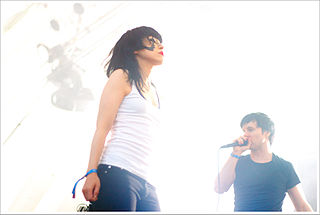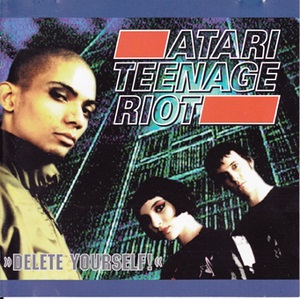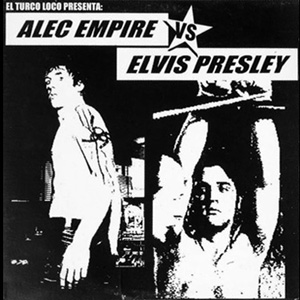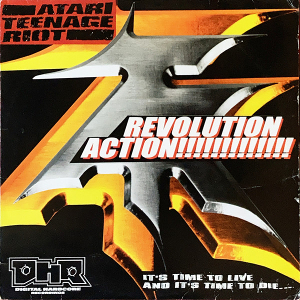
Atari Teenage Riot (ATR) is a German band formed in Berlin in 1992. Highly political, they fuse anarchist and anti-fascist views with punk vocals and a techno sound called digital hardcore, which is a term band member Alec Empire used as the name of his record label Digital Hardcore Recordings.

Hanin Elias is a Syrian German industrial/techno artist. She was a member of Atari Teenage Riot and is now a solo artist.
Digital hardcore is a fusion genre that combines hardcore punk with electronic dance music genres such as breakbeat, techno, and drum and bass while also drawing on heavy metal and noise music. It typically features fast tempos and aggressive sound samples. The style was pioneered by Alec Empire of the German band Atari Teenage Riot during the early 1990s, and often has sociological or leftist lyrical themes.

Alec Empire is a German experimental electronic musician who is best known as a founding member of the band Atari Teenage Riot, as well as a solo artist, producer and DJ. He has released many albums, EPs and singles, some under aliases, and remixed over seventy tracks for various artists including Björk. He was also the driving force behind the creation of the digital hardcore genre, and founded the record labels Digital Hardcore Recordings and Eat Your Heart Out Records.

Embrace was a short-lived American hardcore band from Washington, D.C., active from the summer of 1985 to the spring of 1986. Along with Rites of Spring, and Beefeater, it was one of the mainstay acts of the 1985 Revolution Summer movement, and was one of the first bands to be dubbed in the press as emotional hardcore, though the members had rejected the term since its creation. The band included lead vocalist Ian MacKaye of the defunct hardcore punk act Minor Threat and three former members of his brother Alec's band, the Faith: guitarist Michael Hampton, drummer Ivor Hanson, and bassist Chris Bald.

Most Precious Blood is an American hardcore punk band from New York City formed from the remnants of the band Indecision. They blend the song structures of hardcore with heavy metal, and the band cites Sick of It All, Aphex Twin, The Sisters of Mercy, and The Obsessed as influences, among others. They were signed to Trustkill Records until it dissolved in 2010. They are now with Trustkill president Josh Grabelle's new label Bullet Tooth.
EC8OR is a German digital hardcore band founded in 1995 by Patric Catani and Gina V. D'Orio and signed by Alec Empire's Digital Hardcore Recordings record label. The music was in the same vein of Atari Teenage Riot's style of early Breakcore and hardcore techno with a punk edge, which led to EC8OR been overlooked by fans of digital hardcore recordings, but EC8OR employed more low-res ideas as the first album was entirely composed on Amiga 500 and with a microphone.

Delete Yourself! is the debut album by German digital hardcore band Atari Teenage Riot.

Burn, Berlin, Burn! is a compilation album released by Atari Teenage Riot in 1997. Initially released in the United States by the Beastie Boys' record label Grand Royal, the album is a collection of tracks from their first two albums Delete Yourself! and The Future of War. After Grand Royal Records went defunct, the album was later remastered and re-released on Digital Hardcore Recordings.

Matt Pizzolo is an American film director, screenwriter, producer, bestselling comic book writer, playwright, and entrepreneur, best known for his work as writer of the speculative politics comic books Calexit and Young Terrorists, creator of the transmedia franchise Godkiller, writer-director of the indie movie Threat, and director of music videos for Atari Teenage Riot.
HALO-8 Entertainment is an independent film company specializing in genre cinema, documentaries, midnight movies, music-driven lifestyle videos, and animation. Its most popular releases include the films Pop Skull and Threat, the animated series Godkiller and Xombie, the fitness yoga franchise, Fitness For Indie Rockers, and the documentaries Grant Morrison: Talking With Gods, Your Mommy Kills Animals, N.Y.H.C., and Ctrl+Alt+Compete.

Alec Empire vs. Elvis Presley is a recording by Alec Empire which incorporates Elvis Presley samples.

Atari Teenage Riot: 1992–2000 is a greatest hits compilation by the seminal digital hardcore band Atari Teenage Riot. The album was released on band member Alec Empire's Digital Hardcore Recordings on 3 July 2006 and features 18 tracks from the band's back catalogue.

American Hardcore: The History of American Punk Rock 1980–1986 is a documentary directed and produced by Paul Rachman and written by Steven Blush. It is based on the 2001 book American Hardcore: A Tribal History also written by Blush. It world premiered at the 2006 Sundance Film Festival and was released on September 22, 2006 on a limited basis by Sony Pictures Classics. The film features some early pioneers of the hardcore punk music scene including Bad Brains, Black Flag, D.O.A., Minor Threat, Minutemen, SSD, and others. It was released on DVD by Sony Pictures Home Entertainment on February 20, 2007.

The Future of War is the second studio album by Atari Teenage Riot.

The Destroyer is an album by electronic artist Alec Empire, his first on his own record label Digital Hardcore Recordings, released in 1996 in Europe and a revised version in 1998 in United States. Destroyer is also the name given to a series of EPs by Empire released two years before. Unlike his previous albums for Mille Plateaux, The Destroyer had a much heavier sound more akin to that of his band Atari Teenage Riot, and is considered one of the earliest examples of a breakcore record. Producer Enduser named the album as an inspiration for his music. The album peaked at #54 on the CMJ Radio Top 200 in the U.S.
DiY-Fest "the touring carnival of Do-it-Yourself mediamaking" was a festival of ultra-independent movies, books, zines, music, poetry, and performance art that ran from 1999 until 2002.
The following is a list of known recordings by or involving Alec Empire, excluding his work with Atari Teenage Riot.

Revolution Action E.P. is an extended play by the German digital hardcore group Atari Teenage Riot, released in 1999 on 12" vinyl and CD formats to promote the album 60 Second Wipe Out, where the title track originates. Two music videos were produced for the track, one of which was actually banned by MTV. "Revolution Action" was also the name of a tour and live various artist release titled Revolution Action Japan Tour 1999 EP.

Godkiller is a transmedia series of graphic novels, illustrated films, and novels created by filmmaker Matt Pizzolo that tells the stories of human beings caught in the crossfire of warring fallen gods.






















